
Bronze sculpture has long been a medium for artists to explore phenomenological and perceptual themes, capturing the essence of human experience and sensory interpretation. Among the most recurring subjects in this genre is the human figure, often depicted in abstract or distorted forms to evoke emotional and psychological depth. Artists use bronze's malleability to emphasize movement, tension, or introspection, reflecting the fluidity of perception.
Another prevalent theme is nature, where organic shapes and textures symbolize the interconnectedness of life and consciousness. Abstract geometric compositions also appear frequently, challenging viewers to engage with spatial relationships and subjective interpretations. Mythological and spiritual motifs further enrich this artistic tradition, bridging tangible form with intangible existential questions.
Ultimately, these bronze sculptures serve as tactile manifestations of perception itself—inviting audiences to not just see, but feel the layers of meaning embedded in each crafted surface.

